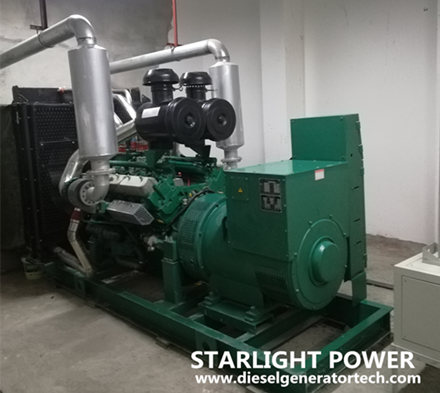Does diesel generator need to be grounded? The answer is Yes. Diesel generator must be grounded, because once the leakage of electricity occurs, it will produce a circuit with the earth, seriously affecting the safety of people.
The grounding protection of diesel generator is used in the ungrounded neutral system of three-phase power supply. Its function is that once the insulation of electrical equipment is damaged and leakage of electricity occurs, the human body contacts the charged shell. At this time, the human body resistance is far greater than the resistance of the grounding body (40). A large amount of current is discharged into the earth through the metal shell, and the voltage to the ground can be reduced to below the safe voltage of 36V.
If we adopt grounding protection, when we touches the shell, due to the parallel connection between our body resistance and the grounding resistance, due to the human body resistance far greater than the grounding resistance, the current passing through the human body is very small, so there is no risk of electric shock.
Therefore, in order to ensure our safety, diesel generators must be grounded.
When connecting diesel generator set, pay attention to the follow points:
1.The ground wire connection point is generally at the end of the chassis of the diesel generator set. When installing the ground wire, it must be connected to the appropriate ground wire position.
2.The connection of the grounding neutral wire of the alternator is usually determined by the installation of the user. When the diesel generator set is the only power supply, the neutral line must be directly connected to the factory grounding wire.
3.For more complex installation, the grounding neutral point shall be selected to ensure the correct operation or protection devices of diesel generator set, such as finding the grounding fault and minimizing the grounding circulating current.
4.The maintenance of the grounding system shall be carried out in strict accordance with the instructions.
Generator neutral grounding is the most widely used mode. Generator neutral grounding mode is related to the magnitude of stator single-phase ground fault current, over-voltage of stator winding, realization of stator ground protection and other factors.

Here we also share the fault of one point ground of generator rotor.
Fault phenomenon:
1.One point earthing alarm for rotor.
2.The positive and negative indication values of the rotor insulation monitoring voltmeter increase obviously, and the sum of the positive and negative voltage of the rotor is close to or equal to the rotor voltage.
Troubleshooting:
A. Check why there is alarm and stop the alarm sound.
B. Switch over the rotor insulation device, measure the positive and negative voltage of the rotor to the ground, judge which side the rotor is grounded close to, judge the grounding property, and whether it is metal grounded.
C. Ask if any personnel touch the excitation circuit by mistake.
D. Check whether the excitation circuit has obvious grounding.
E. Check whether the meters and protective devices of excitation circuit are grounded.
F. Check whether the rotor coil occurs water leakage.
G. In the process of finding one point grounding of the rotor, if it is found that the unit has under excitation or loss of excitation, it is considered that the rotor has developed from one point grounding to two-point grounding or accompanied by water leakage of the generator, then the generator shall be disconnected in an emergency.
H. Change the automatic excitation to manual excitation operation and exit the forced excitation pressing plate.
I. If it is confirmed that the generator rotor is grounded from one point to two-point grounding protection, here are operation steps for putting the rotor into two-point grounding protection:
a. Check the pressing plates of the trip switch of generator and the de excitation switch of the rotor are in the off position.
b. Check that the grounding carbon brush of generator main shaft is in good contact.
c. Switch the switch in the rotor grounding protection device to the "two-point grounding" position.
d. Adjust the potentiometer to make the voltmeter indicate zero.
e. Press the button and adjust the potentiometer to zero.
f. Use a high internal resistance multimeter to measure that there is no voltage at both ends of the pressing plate, then put in the pressing plate of the trip switch of generator and the deexcitation switch.
g. Phenomenon of two-point grounding of generator excitation circuit: the excitation current is abnormal, the excitation voltage is reduced or close to zero, the reactive power indication is reduced, the unit has strong vibration, when the two-point grounding protection is put into operation, the generator transformer unit trips.
h. According to the phenomenon, it is judged that the two-point ground fault of the generator is caused by the two-point ground fault of the generator excitation circuit. If the protection fails to trip, the generator shall be disconnected immediately.
i. When the rotor insulation treatment is recovered, the one point grounding signal will be reset, and the two-point grounding protection of rotor will be withdrawn immediately, and the one point grounding protection of rotor will be put into operation.
Comments
Post a Comment